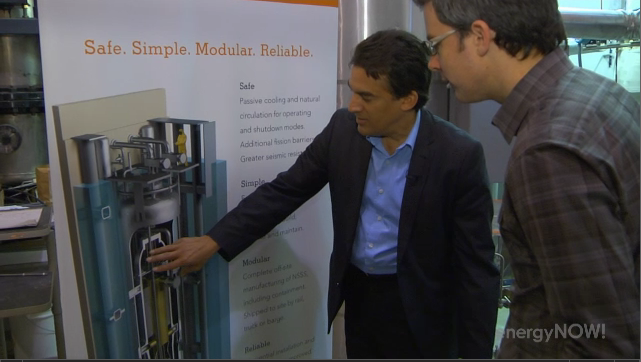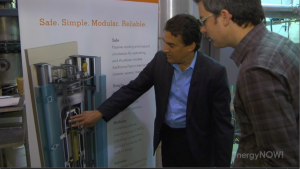America’s nuclear power renaissance has been just around the corner for years, it seems. Even though 20 percent of all U.S. electricity is generated by nuclear power plants, without any greenhouse gas emissions, safety and cost concerns mean no new plants have been built in decades.
But a new breed of nuclear reactor could unlock the power of the atom in a safe, affordable way. energyNOW! correspondent Daniel Sieberg explores the promise of small modular reactors (SMR) – simple enough to be scalable, powerful enough to power a whole town, and safe enough to be buried underground.

Nuclear scientists at NuScale Energy in Oregon think they have figured out a way to realize the potential of SMRs without the concerns of traditional nuclear power. Their SMR is small, producing 45 megawatts (MW), enough to power 45,000 homes. That’s a far cry from the iconic 1,000-MW nuclear power plants we’re used to, but they’re designed to be mass-produced at the same cost of comparable forms of generation.
The secret is simple — an uncomplicated design. “The concept is just a reactor inside, essentially, a stainless steel thermos bottle, underwater, underground,” said Jose Reyes, NuScale’s founder. Reyes says NuScale will submit the design certification document to the Nuclear Regulatory Commission (NRC) in 2012, expect NRC approval by 2015, and could bring the first plant online by 2018.
SMRs hold the potential to make nuclear power cheaper and safer, and they could also help reduce the legacy of America’s nuclear arms race. One company, Savannah River Nuclear Solutions, has signed a deal with General Electric to use weapons-grade plutonium left over from the Cold War to power another SMR design. “Let’s get rid of our nuclear weapons,” said Eric Loewen of General Electric. “We see this reactor as a way to do that.”
Still, the story of nuclear power will always be inextricably connected to the question of safety — especially in a post-Fukushima world. This point does not go unnoticed by the environmental community. “The nuclear industry has done an excellent job of selling the concept of nuclear power as clean and green,” said Michele Boyd, of the Physicians for Social Responsibility. “If you ask people in general, ‘do you want one next to your house?’ the percentage of people who do decreases significantly.”
Reyes thinks SMR design is indicative of how the nuclear industry’s approach to safety is evolving. “We have online simulations which allow you to look at different events in the plant, as well as modeling events in advance,” he said. “These are assessments of every valve and component…it’s a much more comprehensive safety approach.”
And some international observers agree. The International Atomic Energy Agency in Vienna predicts that by 2030, over 300 SMRs will be deployed globally. But like many other predictions about nuclear power, only time will tell if SMRs are the future of clean power, or just another nuclear renaissance that’s perpetually right around the corner.
Source: cleantechnica

 Follow
Follow